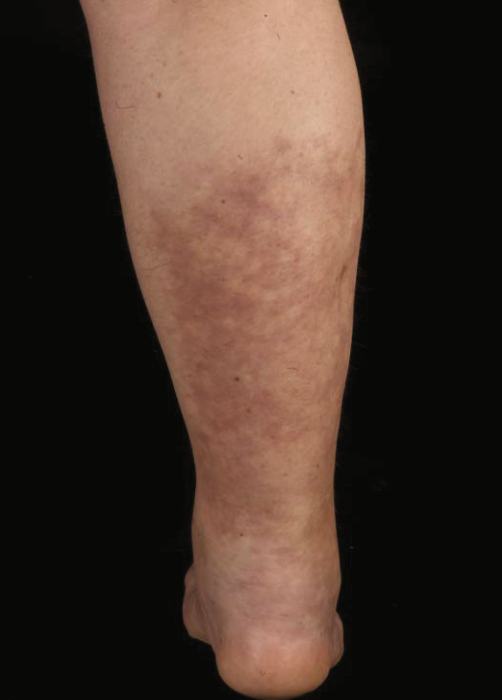WBR0656
Jump to navigation
Jump to search
| Author | [[PageAuthor::Ayokunle Olubaniyi, M.B,B.S [1] (Reviewed by Serge Korjian)]] |
|---|---|
| Exam Type | ExamType::USMLE Step 1 |
| Main Category | MainCategory::Pathology |
| Sub Category | SubCategory::Musculoskeletal/Rheumatology |
| Prompt | [[Prompt::A 34-year-old man is brought to the emergency department with acute onset of fever, malaise, abdominal pain, and bloody stools. His family reports that he has not been well and has lost at least 5 kg (11 lbs) in the past 3 weeks. On physical examination, you notice lower extremity edema with an overlying lace like skin rash (shown below). Further questioning reveals that patient was recently diagnosed with hepatitis B. Work-up shows reduced levels of serum complement. Skin biopsy of the rash demonstrates small and medium vessel inflammatory changes. What is the most likely diagnosis in this patient? |
| Answer A | AnswerA::Giant cell arteritis |
| Answer A Explanation | AnswerAExp::Giant cell arteritis or temporal arteritis is medium to large vessel vasculitis that predominantly affects the branches of the external carotid artery. Features include jaw pain, ocular disturbances and an elevated ESR. |
| Answer B | AnswerB::Thromboangiitis obliterans |
| Answer B Explanation | AnswerBExp::Thromboangiitis obliterans or Buerger’s disease is a small and medium vessel vasculitis that affects the hands and feet. It is strongly associated with smoking. |
| Answer C | AnswerC::Kawasaki syndrome |
| Answer C Explanation | [[AnswerCExp::Kawasaki disease is a medium-sized vasculitis classically observed in children under five years of age. It is characterized by conjunctival and oral erythema (red-strawberry tongue), fever, erythema and edema of the palms and soles, generalized rash, and cervical lymph node swelling.]] |
| Answer D | AnswerD::Polyarteritis nodosa |
| Answer D Explanation | AnswerDExp::Polyarteritis nodosa (PAN) is a small and medium-size vasculitis that affects the kidneys, heart, and GI tract. Approximately 25% of patients with PAN have positive a hepatitis B serum antigen. |
| Answer E | AnswerE::Takayasu’s arteritis |
| Answer E Explanation | AnswerEExp::Takayasu’s arteritis or pulseless disease, is a form of large vessel granulomatous vasculitis with massive intimal fibrosis and vascular narrowing, affecting often young or middle-aged women usually of Asian descent. |
| Right Answer | RightAnswer::D |
| Explanation | [[Explanation::Polyarteritis nodosa (PAN) is a vasculitis that mainly affects the small and medium-sized arteries, particularly the at the level of the kidneys, heart, and GI tract. Classical symptoms are non-specific and include fever, malaise, anorexia, weight loss, and myalgias. Physical examination is often remarkable for soft tissue edema, rashes (livedo relicularis; lace like rash shown in this patient), petechiae, and ulcerations. Depending on the involved system, manifestations include numbness and paresthesias, strokes, seizures, renal insufficiency, myocardial infarction or pericarditis. Approximately 25% of patients with PAN have positive a hepatitis B serum antigen. In fact, according to the American College of Rheumatology (ACR) diagnostic criteria, hepatitis B status is taken into consideration. Diagnosis is generally based on the clinical picture, laboratory studies (CBC, ESR, C-reactive protein, p-ANCA), and biopsy. Treatment involves the use of immunosuppressants – prednisone, cyclophosphamide and methotrexate. Educational Objective: Polyarteritis nodosa is a vasculitis involving the small and medium sized arteries, particularly the renal, cardiac, and gastrointestinal tract vessels. One of the classical features is the characteristic lace-like rash known as livedo reticularis. PAN is associated with hepatitis B infection. |
| Approved | Approved::Yes |
| Keyword | WBRKeyword::Polyarteritis nodosa, WBRKeyword::Takayasu’s arteritis, WBRKeyword::Kawasaki disease, WBRKeyword::Thromboangiitis obliterans, WBRKeyword::Temporal arteritis |
| Linked Question | Linked:: |
| Order in Linked Questions | LinkedOrder:: |
